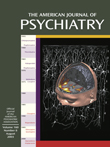Abstract
OBJECTIVE: Atypical antipsychotic drug treatment is clinically effective with a low risk of extrapyramidal symptoms. Explanations for the mechanism underlying this beneficial therapeutic profile of atypical over typical antipsychotic agents include 1) simultaneous antagonism of dopamine D2 and serotonin 5-HT2A receptors or 2) selective action at limbic cortical dopamine D2-like receptors with modest striatal D2 receptor occupancy. Amisulpride is an atypical antipsychotic drug with selective affinity for D2/D3 dopamine receptors and provides a useful pharmacological model for examining these hypotheses. The authors’ goal was to evaluate whether treatment with amisulpride results in “limbic selective” D2/D3 receptor blockade in vivo. METHOD: Five hours of dynamic single photon emission tomography data were acquired after injection of [123I]epidepride (approximately 150 MBq). Kinetic modeling was performed by using the simplified reference region model to obtain binding potential values. Estimates of receptor occupancy were made relative to a healthy volunteer comparison group (N=6). RESULTS: Eight amisulpride-treated patients (mean dose=406 mg/day) showed moderate levels of D2/D3 receptor occupancy in the striatum (56%), and significantly higher levels were seen in the thalamus (78%) and temporal cortex (82%). CONCLUSIONS: Treatment with amisulpride results in a similar pattern of limbic cortical over striatal D2/D3 receptor blockade to that of other atypical antipsychotic drugs. This finding suggests that modest striatal D2 receptor occupancy and preferential occupancy of limbic cortical dopamine D2/D3 receptors may be sufficient to explain the therapeutic efficacy and low extrapyramidal symptom profile of atypical antipsychotic drugs, without the need for 5-HT2A receptor antagonism.



